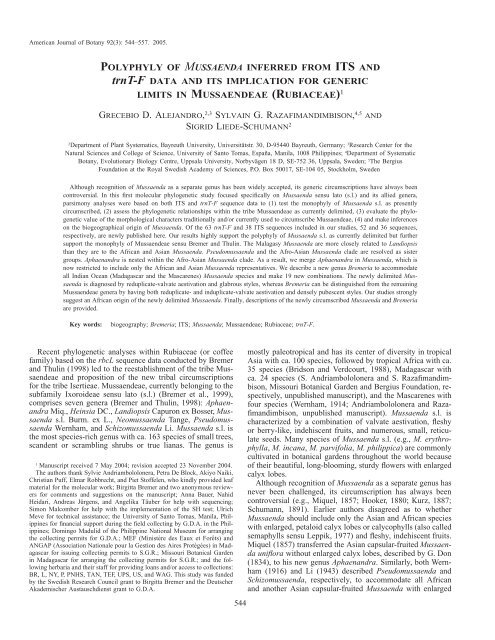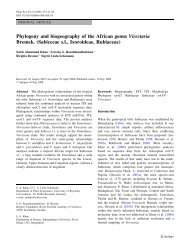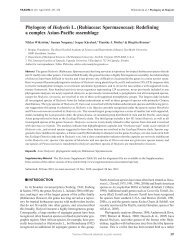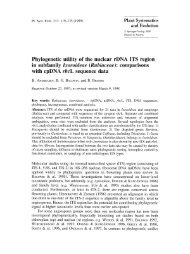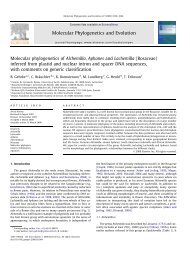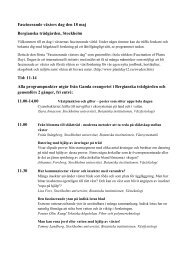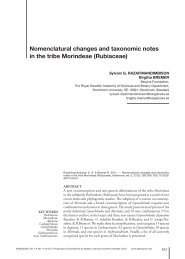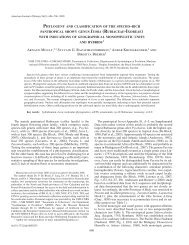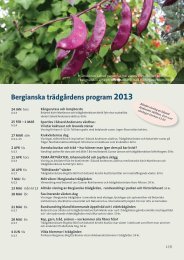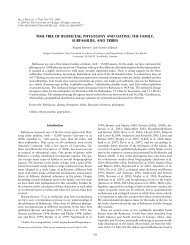Alejandro et al. 2005
Alejandro et al. 2005
Alejandro et al. 2005
Create successful ePaper yourself
Turn your PDF publications into a flip-book with our unique Google optimized e-Paper software.
American Journ<strong>al</strong> of Botany 92(3): 544–557. <strong>2005</strong>.POLYPHYLY OF MUSSAENDA INFERRED FROM ITS ANDtrnT-F DATA AND ITS IMPLICATION FOR GENERICLIMITS IN MUSSAENDEAE (RUBIACEAE) 1GRECEBIO D. ALEJANDRO, 2,3 SYLVAIN G. RAZAFIMANDIMBISON, 4,5 ANDSIGRID LIEDE-SCHUMANN 22Department of Plant Systematics, Bayreuth University, Universitätstr. 30, D-95440 Bayreuth, Germany; 3 Research Center for theNatur<strong>al</strong> Sciences and College of Science, University of Santo Tomas, España, Manila, 1008 Philippines; 4 Department of SystematicBotany, Evolutionary Biology Centre, Upps<strong>al</strong>a University, Norbyvägen 18 D, SE-752 36, Upps<strong>al</strong>a, Sweden; 5 The BergiusFoundation at the Roy<strong>al</strong> Swedish Academy of Sciences, P.O. Box 50017, SE-104 05, Stockholm, SwedenAlthough recognition of Mussaenda as a separate genus has been widely accepted, its generic circumscriptions have <strong>al</strong>ways beencontroversi<strong>al</strong>. In this first molecular phylogen<strong>et</strong>ic study focused specific<strong>al</strong>ly on Mussaenda sensu lato (s.l.) and its <strong>al</strong>lied genera,parsimony an<strong>al</strong>yses were based on both ITS and trnT-F sequence data to (1) test the monophyly of Mussaenda s.l. as presentlycircumscribed, (2) assess the phylogen<strong>et</strong>ic relationships within the tribe Mussaendeae as currently delimited, (3) ev<strong>al</strong>uate the phylogen<strong>et</strong>icv<strong>al</strong>ue of the morphologic<strong>al</strong> characters tradition<strong>al</strong>ly and/or currently used to circumscribe Mussaendeae, (4) and make inferenceson the biogeographic<strong>al</strong> origin of Mussaenda. Of the 63 trnT-F and 38 ITS sequences included in our studies, 52 and 36 sequences,respectively, are newly published here. Our results highly support the polyphyly of Mussaenda s.l. as currently delimited but furthersupport the monophyly of Mussaendeae sensu Bremer and Thulin. The M<strong>al</strong>agasy Mussaenda are more closely related to Landiopsisthan they are to the African and Asian Mussaenda. Pseudomussaenda and the Afro-Asian Mussaenda clade are resolved as sistergroups. Aphaenandra is nested within the Afro-Asian Mussaenda clade. As a result, we merge Aphaenandra in Mussaenda, which isnow restricted to include only the African and Asian Mussaenda representatives. We describe a new genus Bremeria to accommodate<strong>al</strong>l Indian Ocean (Madagascar and the Mascarenes) Mussaenda species and make 19 new combinations. The newly delimited Mussaendais diagnosed by reduplicate-v<strong>al</strong>vate aestivation and glabrous styles, whereas Bremeria can be distinguished from the remainingMussaendeae genera by having both reduplicate- and induplicate-v<strong>al</strong>vate aestivation and densely pubescent styles. Our studies stronglysuggest an African origin of the newly delimited Mussaenda. Fin<strong>al</strong>ly, descriptions of the newly circumscribed Mussaenda and Bremeriaare provided.Key words:biogeography; Bremeria; ITS; Mussaenda; Mussaendeae; Rubiaceae; trnT-F.Recent phylogen<strong>et</strong>ic an<strong>al</strong>yses within Rubiaceae (or coffeefamily) based on the rbcL sequence data conducted by Bremerand Thulin (1998) led to the reestablishment of the tribe Mussaendeaeand proposition of the new trib<strong>al</strong> circumscriptionsfor the tribe Isertieae. Mussaendeae, currently belonging to thesubfamily Ixoroideae sensu lato (s.l.) (Bremer <strong>et</strong> <strong>al</strong>., 1999),comprises seven genera (Bremer and Thulin, 1998): AphaenandraMiq., Heinsia DC., Landiopsis Capuron ex Bosser, Mussaendas.l. Burm. ex L., Neomussaenda Tange, PseudomussaendaWernham, and Schizomussaenda Li. Mussaenda s.l. isthe most species-rich genus with ca. 163 species of sm<strong>al</strong>l trees,scandent or scrambling shrubs or true lianas. The genus is1Manuscript received 7 May 2004; revision accepted 23 November 2004.The authors thank Sylvie Andriambololonera, P<strong>et</strong>ra De Block, Akiyo Naiki,Christian Puff, Elmar Robbrecht, and Pi<strong>et</strong> Stoffelen, who kindly provided leafmateri<strong>al</strong> for the molecular work; Birgitta Bremer and two anonymous reviewersfor comments and suggestions on the manuscript; Anna Bauer, NahidHeidari, Andreas Jürgens, and Angelika Täuber for help with sequencing;Simon M<strong>al</strong>comber for help with the implementation of the SH test; UlrichMeve for technic<strong>al</strong> assistance; the University of Santo Tomas, Manila, Philippinesfor financi<strong>al</strong> support during the field collecting by G.D.A. in the Philippines;Domingo Madulid of the Philippine Nation<strong>al</strong> Museum for arrangingthe collecting permits for G.D.A.; MEF (Ministère des Eaux <strong>et</strong> Forêts) andANGAP (Association Nation<strong>al</strong>e pour la Gestion des Aires Protégées) in Madagascarfor issuing collecting permits to S.G.R.; Missouri Botanic<strong>al</strong> Gardenin Madagascar for arranging the collecting permits for S.G.R.; and the followingherbaria and their staff for providing loans and/or access to collections:BR, L, NY, P, PNHS, TAN, TEF, UPS, US, and WAG. This study was fundedby the Swedish Research Council grant to Birgitta Bremer and the DeutscherAkademischer Austauschdienst grant to G.D.A.mostly p<strong>al</strong>eotropic<strong>al</strong> and has its center of diversity in tropic<strong>al</strong>Asia with ca. 100 species, followed by tropic<strong>al</strong> Africa with ca.35 species (Bridson and Verdcourt, 1988), Madagascar withca. 24 species (S. Andriambololonera and S. Razafimandimbison,Missouri Botanic<strong>al</strong> Garden and Bergius Foundation, respectively,unpublished manuscript), and the Mascarenes withfour species (Wernham, 1914; Andriambololonera and Razafimandimbison,unpublished manuscript). Mussaenda s.l. ischaracterized by a combination of v<strong>al</strong>vate aestivation, fleshyor berry-like, indehiscent fruits, and numerous, sm<strong>al</strong>l, r<strong>et</strong>iculateseeds. Many species of Mussaenda s.l. (e.g., M. erythrophylla,M. incana, M. parvifolia, M. philippica) are commonlycultivated in botanic<strong>al</strong> gardens throughout the world becauseof their beautiful, long-blooming, sturdy flowers with enlargedc<strong>al</strong>yx lobes.Although recognition of Mussaenda as a separate genus hasnever been ch<strong>al</strong>lenged, its circumscription has <strong>al</strong>ways beencontroversi<strong>al</strong> (e.g., Miquel, 1857; Hooker, 1880; Kurz, 1887;Schumann, 1891). Earlier authors disagreed as to wh<strong>et</strong>herMussaenda should include only the Asian and African specieswith enlarged, p<strong>et</strong><strong>al</strong>oid c<strong>al</strong>yx lobes or c<strong>al</strong>ycophylls (<strong>al</strong>so c<strong>al</strong>ledsemaphylls sensu Leppik, 1977) and fleshy, indehiscent fruits.Miquel (1857) transferred the Asian capsular-fruited Mussaendauniflora without enlarged c<strong>al</strong>yx lobes, described by G. Don(1834), to his new genus Aphaenandra. Similarly, both Wernham(1916) and Li (1943) described Pseudomussaenda andSchizomussaenda, respectively, to accommodate <strong>al</strong>l Africanand another Asian capsular-fruited Mussaenda with enlarged544
March <strong>2005</strong>] ALEJANDRO ET AL.—POLYPHYLY OF MUSSAENDA (RUBIACEAE)545c<strong>al</strong>yx lobes. On the other hand, Candolle (1830), <strong>al</strong>so endorsedby Hooker (1880), Kurz (1887), and Schumann (1891), recognizeda broad circumscription including Mussaenda specieswith or without semaphylls and with dehiscent or indehiscentfruits. This broad circumscription appears never to have gainedacceptance. Mussaenda s.l. as presently circumscribed (e.g.,Robbrecht, 1988; Puff <strong>et</strong> <strong>al</strong>., 1993; Mabberley, 1997) includes<strong>al</strong>l Afro-Asian and M<strong>al</strong>agasy Mussaenda species with indehiscentfruits and with or without semaphylls. This situationraises questions as to wh<strong>et</strong>her one of these three conflictinggeneric limits circumscribes a monophyl<strong>et</strong>ic unit. The presentstudy is the first phylogen<strong>et</strong>ic investigation to focus specific<strong>al</strong>lyon Mussaenda s.l. and its <strong>al</strong>liances.Previous phylogen<strong>et</strong>ic studies of some Rubiaceae groupshave shown that both the intern<strong>al</strong> transcribed spacer (ITS) regionof nuclear rDNA (e.g., Andreasen <strong>et</strong> <strong>al</strong>., 1999; Persson,2000; Razafimandimbison and Bremer, 2001) and the trnT-Fregion of chloroplast DNA (e.g., Razafimandimbison and Bremer,2002) were useful for assessing phylogen<strong>et</strong>ic relationshipsat both generic and trib<strong>al</strong> levels. The first objective ofthe present study is to reconstruct robust phylogenies for Mussaendas.l. and its <strong>al</strong>lied genera using both the ITS and trnT-F sequence data. The resulting phylogenies will then be usedto: (1) test the monophyly of Mussaenda s.l., (2) assess thephylogen<strong>et</strong>ic relationships within the tribe Mussaendeae ascurrently delimited, (3) ev<strong>al</strong>uate the phylogen<strong>et</strong>ic v<strong>al</strong>ue of themorphologic<strong>al</strong> characters tradition<strong>al</strong>ly and/or currently used tocircumscribe Mussaendeae, and (4) make inferences on thebiogeographic<strong>al</strong> origin of Mussaenda.MATERIALS AND METHODSTaxon sampling—Materi<strong>al</strong> was available for <strong>al</strong>l genera currently placed inMussaendeae sensu Bremer and Thulin (1998) except for Neomussaenda. Atot<strong>al</strong> of 37 Mussaendeae species, representing four individu<strong>al</strong>s of Aphaenandra,three Heinsia species, three Pseudomussaenda and 25 Mussaenda s.l.species, as well as one individu<strong>al</strong> each of the two monotypic genera Landiopsisand Schizomussaenda, was included in our an<strong>al</strong>yses. Twelve genera(Acranthera, Gonz<strong>al</strong>agunia, Hippotis, Hoffmania, Isertia, Myc<strong>et</strong>ia, Pauridiantha,Pentagonia, Pseudosabicea, Sabicea, Schradera, and Sommera) tradition<strong>al</strong>lyassociated with Mussaendeae and Isertieae sensu Robbrecht (1988)were <strong>al</strong>so added in the trnT-F an<strong>al</strong>ysis to test the monophyly of Mussaendeaesensu Bremer and Thulin (1998). Few representatives of Cinchonoideae sensuRobbrecht (1988), Ixoroideae, and Rubioideae were addition<strong>al</strong>ly investigated(see Appendix in Supplement<strong>al</strong> Data accompanying online version of thisarticle). The genus Luculia, which has been shown to be bas<strong>al</strong> in Rubiaceae(Bremer <strong>et</strong> <strong>al</strong>., 1999), was used as the outgroup to root the trnT-F tree. Originsand voucher specimens are listed in Appendix.DNA extraction and amplification—Tot<strong>al</strong> DNA was extracted from fresh,silica-gel dried leaf tissues (Chase and Hills, 1991) or herbarium materi<strong>al</strong>using DNeasy Plant Mini kit (Qiagen, Hilden, Germany) and cleaned withQia-Quick PCR purification kit (Qiagen). For amplification and sequencingof the trnT-F, the protocols are described in Razafimandimbison and Bremer(2002).The ITS region (ITS1, 5.8S gene, and ITS2) was amplified using primersP17F (5-CTA CCG ATT GAA TGG TCC GGT GAA-3) and 26S–82R (5-TCC CGG TTC GCT CGC CGT TAC TA-3) (Popp and Oxelman, 2001).PCR cocktails were mixed as follows (25 L): 15.3 L dH 2 O, 2.5 L 10PCR buffer, 2.0 L 25 mM MgCl 2, 1.5 L 2 mM dNTP, 1.0 L of10Mforward and reverse primers, respectively, 0.2 L Taq DNA polymerase, and1.5 L DNA. The Q-solution (Qiagen) was <strong>al</strong>so used as additive replacingsome of the water. PCR reactions were run on a Biom<strong>et</strong>ra UNO-Thermoblockcycler with initi<strong>al</strong> denaturation for 90 s at 97C, followed by 35 cycles of 20s97C, 90 s 72C,1:30s72C, finishing with 72C for 7 min. PCR productswere cleaned with Qia-Quick PCR purification kit (Qiagen).Sequencing reactions were done using primers P16F (5-TCA CTG AACCTT ATC ATT TAG AGG-3) and P25R (5- GGG TAG TCC CGC CTGACC TG-3) (Popp and Oxelman, 2001) and the ABI PRISM Big Dye TerminatorCycle sequencing kit (Applied Biosystems, Bayreuth, Germany). Allsequencing was performed on an ABI Prism Model 310, version 3.0 sequencer.Data an<strong>al</strong>ysis—The ITS and trnT-F sequences were assembled using thePerkin Elmer Sequence Navigator, version 1.0.1 and Sequencher 3.1.1, respectively,and edited manu<strong>al</strong>ly. All new sequences were submitted to EMBL,and their accession numbers are in Appendix (see Supplement<strong>al</strong> Data foronline version of this article). We performed parsimony phylogen<strong>et</strong>ic an<strong>al</strong>ysesat two distinct but interrelated levels. We initi<strong>al</strong>ly conducted a large-sc<strong>al</strong>ephylogen<strong>et</strong>ic an<strong>al</strong>ysis based on the trnT-F data, including the 36 taxa of Mussaendeaesensu Bremer and Thulin (1998), 12 genera previously placed inMussaendeae, 14 distantly related Rubiaceae taxa from Cinchonoideae, Ixoroideaes.l., and Rubioideae, and one outgroup taxon, for a tot<strong>al</strong> of 63 taxa.The results of this an<strong>al</strong>ysis <strong>al</strong>lowed us to select new outgroup taxa (Sabiceadiversifolia and Warszewiczia coccinea) from within Ixoroideae s.l. to rootboth the ITS and combined ITS-trnT-F an<strong>al</strong>yses of taxa from Mussaendeaesensu Bremer and Thulin (1998). The parsimony an<strong>al</strong>yses of the ITS, trnT-F, and combined ITS-trnT-F data s<strong>et</strong>s (excluding uninformative characters)were performed with PAUP* version 4.0b (Swofford, 2000) on a Power MacintoshG3 computer using heuristic searches, with the MULTREES option on,tree-bisection-reconnection (TBR) branch swapping, swap on best only ineffect, and 5000 random addition sequences. The heuristic search for the trnT-F an<strong>al</strong>ysis could not be compl<strong>et</strong>ed due to computation<strong>al</strong> limitations. The trnT-F data were then an<strong>al</strong>yzed using the following s<strong>et</strong>tings: the MULTREES optionoff, nearest neighbor interchanges (NNI) branch swapping, and 10 000random addition sequences. For the combined ITS-trnT-F data s<strong>et</strong>s, we likewisesearched for multiple islands of most-parsimonious trees (Maddison,1991). In <strong>al</strong>l an<strong>al</strong>yses, characters were given equ<strong>al</strong> weight, gaps were treatedas missing data, and phylogen<strong>et</strong>ic<strong>al</strong>ly informative indels were coded followingthe simple gap coding m<strong>et</strong>hod of Simmons and Ochoterena (2000). The consistencyindex (CI; Kluge and Farris, 1969) and r<strong>et</strong>ention index (RI; Farris,1989) were c<strong>al</strong>culated to estimate homoplasy. Bootstrap (BS; Felsenstein,1985) v<strong>al</strong>ues using 10 000 replicates, the MULTREES option off, NNI branchswapping, and five random addition sequences were performed to assess relativesupport for the identified clades. Clades receiving a bootstrap supportof 50–69% were regarded as weakly supported, 70–85% as moderately supported,and 86–100% as strongly supported.We statistic<strong>al</strong>ly ev<strong>al</strong>uated the combinability of the ITS and trnT-F datapartitions using the one-tailed Shimodaira-Hasegawa test (SH test; Shimodairaand Hasegawa, 1999; Goldman <strong>et</strong> <strong>al</strong>., 2000) and the incongruence lengthdifference (ILD test; Farris <strong>et</strong> <strong>al</strong>., 1995), both implemented in PAUP*. Weperfomed maximum likelihood (ML) an<strong>al</strong>yses of the ITS and trnT-F data,respectively, using the GTR G I and the GTR G substitution models,which were selected by MrModeltest (Nylander, 2002) as the best models.We subsequently conducted the SH tests, using resampling estimated by loglikelihood(RELL) optimization and 1000 bootstrap replicates, to comparestatistic<strong>al</strong>ly the optim<strong>al</strong> ITS and trnT-F topologies, respectively, against two<strong>al</strong>ternative phylogen<strong>et</strong>ic hypotheses: topology inferred from the ITS data constrainedby the optim<strong>al</strong> ML topology of the trnT-F data (for the ITS matrix)and topology from the trnT-F data constrained by the best topology from theITS data (for the trnT-F partition).Incongruency test was performed using the incongruence length difference(ILD test; Farris <strong>et</strong> <strong>al</strong>., 1995) to assess incongruencies b<strong>et</strong>ween the ITS andtrnT-F data s<strong>et</strong>s. This test uses the partition-homogeneity test as implementedin PAUP* (Swofford, 2000). The heuristic search was s<strong>et</strong> to 500 replicateswith 10 random addition sequence and NNI branch swapping. If the probabilityof obtaining a sm<strong>al</strong>ler sum of tree lengths from the randomly generateddata s<strong>et</strong>s is lower (P 0.05) than that of the origin<strong>al</strong> data s<strong>et</strong>s, the nullhypothesis that the two data s<strong>et</strong>s are homogenous is rejected and they areinterpr<strong>et</strong>ed as incongruent (Farris <strong>et</strong> <strong>al</strong>., 1995).
546 AMERICAN JOURNAL OF BOTANY[Vol. 92Fin<strong>al</strong>ly, addition<strong>al</strong> SH tests were performed to test wh<strong>et</strong>her or not the optim<strong>al</strong>ML topologies of both the ITS (Fig. 1) and trnT-F (Fig. 2) trees weresignificantly different from the <strong>al</strong>ternative hypothesis constraining <strong>al</strong>l sampledAfrican Mussaenda species monophyl<strong>et</strong>ic.RESULTSSequence characteristics—The trnT-F sequences of thesampled members of Mussaendeae varied from 1703 basepairs (bp) (Heinsia crinita) to 1793 bp (Mussaenda latisep<strong>al</strong>a).The tot<strong>al</strong> GC content of the trnT-F Mussaendeae sequencesranged from 30.82% (Pseudomussaenda flava) to 36.64%(Mussaenda isertiana) and its average was 31.55%. The ITSsequences of the sampled members of Mussaendeae variedfrom 570 bp (<strong>al</strong>l M<strong>al</strong>agasy Mussaenda included) to 596 bp(Heinsia bussei and H. zanzibarica). The average tot<strong>al</strong> lengthof ITS1 and ITS2 were 204 and 221 bp, respectively. From<strong>al</strong>l Mussaendeae sequences included, ITS2 (215–223 bp) waslonger than ITS1 (185–209 bp), consistent with the earlier reportin Mussaenda erythrophylla (Andreasen <strong>et</strong> <strong>al</strong>., 1999). Theaverage length f<strong>al</strong>ls within the range for other angiosperms(ITS1: 187–298 bp and ITS2: 187–252 bp; B<strong>al</strong>dwin <strong>et</strong> <strong>al</strong>.,1995). The tot<strong>al</strong> GC content of the entire ITS region rangedfrom 59.80% (Schizomussaenda dehiscens) to 63.76% (Landiopsiscapuronii) and its average was 61.19%.TrnT-F an<strong>al</strong>ysis—Of 63 trnT-F sequences included in ourstudies, 52 are newly published here. The non-<strong>al</strong>igned trnT-Fsequences ranged from 1662 bp (Gonz<strong>al</strong>agunia affinis) to 1793bp (Mussaenda latisep<strong>al</strong>a). The trnT-F <strong>al</strong>ignment of 63 taxaconsisted of 2263 positions, 45 (1.99%) of which were codedas phylogen<strong>et</strong>ic<strong>al</strong>ly informative indels and 508 (22.45%) werephylogen<strong>et</strong>ic<strong>al</strong>ly informative characters. Of these informativecharacters, 314 (61.81%) were from the trnT-L spacer, 81(15.94%) from the trnL intron, and 113 (22.24%) from th<strong>et</strong>rnL-F spacer. Within Mussaendeae, <strong>al</strong>ignment of 37 taxa consistedof 1924 positions and contained 131 (7.31%) phylogen<strong>et</strong>ic<strong>al</strong>lyinformative characters. Parsimony an<strong>al</strong>yses of the 63trnT-F sequences data resulted in 1410 equ<strong>al</strong>ly parsimonioustrees (each 1207 steps long [L], CI 0.638, and RI 0.834).In the strict consensus tree shown in Fig. 1, <strong>al</strong>l investigatedmembers of Mussaendeae sensu Bremer and Thulin (1998)formed a strongly supported (BS 100) monophyl<strong>et</strong>ic group.Within the Mussaendeae clade, a tot<strong>al</strong> of four major cladeswere resolved: (1) a strongly supported (BS 100) clade containing<strong>al</strong>l sampled Heinsia species; (2) a highly supported (BS 100) monophyl<strong>et</strong>ic group comprising the sampled Pseudomussaendaspecies; (3) a moderately supported (BS 80)clade forming three African Mussaenda species (M. afzelii, M.grandiflora, and M. isertiana); and (4) a weakly supported (BS 63) clade containing <strong>al</strong>l investigated Asian Mussaenda,Aphaenandra uniflora, and five African Mussaenda species(M. arcuata, M. elegans, M. erythrophylla, M. monticola, andM. nivea). All sampled M<strong>al</strong>agasy Mussaenda, Landiopsis capuronii,and Schizomussaenda dehiscens were left unresolved.Mussaenda s.l. as presently delimited was shown to be polyphyl<strong>et</strong>icbecause the Afro-Asian Mussaenda species were notdirectly related to the M<strong>al</strong>agasy Mussaenda species. Plus, thePseudomussaenda clade was resolved with high support (BS 90) as sister to the Afro-Asian Mussaenda clade. Furthermore,<strong>al</strong>l sampled individu<strong>al</strong>s of A. uniflora formed a stronglysupported (BS 99) monophyl<strong>et</strong>ic group, which was embeddedwithin the Afro-Asian Mussaenda clade. Similarly, weperceived no support for the monophyly of the narrow circumscriptionof Mussaenda that included only the Afro-AsianMussaenda with semaphylls and dehiscent fruits (e.g., Miquel,1857; Wernham, 1916). In contrast, the broadly circumscribedMussaenda including <strong>al</strong>l species with and without semaphyllsand with dehiscent or indehiscent fruits (e.g., Candolle, 1830;Hooker, 1880; Kurz, 1887; Schumann, 1891) was resolvedwith high support (BS 98) as monophyl<strong>et</strong>ic. This clade wasresolved with strong support (BS 100) as sister to the Heinsiaclade.Mussaendeae sensu Bremer and Thulin (1998) was resolvedwith strong support (BS 94) as sister to Sabiceeae (representedby Sabicea diversifolia and Pseudosabicea becqu<strong>et</strong>ii)and placed within Ixoroideae s.l. The remaining Mussaendeaeassociatedgenera included in our study were resolved withhigh support in the three subfamilies: both Myc<strong>et</strong>ia andSchradera in Rubioideae sensu Bremer and Manen (2000);Hoffmania, Gonz<strong>al</strong>agunia, and Isertia <strong>al</strong>l in Cinchonoideaesensu stricto (s.s.) (Bremer <strong>et</strong> <strong>al</strong>., 1995; Bremer <strong>et</strong> <strong>al</strong>., 1999);and Hippotis, Pentagonia, and Sommera <strong>al</strong>l in Ixoroideae s.l.(Bremer <strong>et</strong> <strong>al</strong>., 1999; Rova <strong>et</strong> <strong>al</strong>., 2002). Fin<strong>al</strong>ly, Acrantheraand Mussaendopsis were placed with strong support in Rubioideaeand Ixoroideae s.l., respectively.ITS an<strong>al</strong>ysis—A tot<strong>al</strong> of 38 ITS sequences were includedand 36 are newly published here. The <strong>al</strong>igned matrix contained655 positions and 103 (15.72%) were phylogen<strong>et</strong>ic<strong>al</strong>ly informative,eight (1.22%) of which were coded as phylogen<strong>et</strong>ic<strong>al</strong>lyinformative indels. Of these informative characters, 48(46.60%) were from the ITS1, 53 (51.46%) from the ITS2,and only two (1.94%) from the 5.8S gene. A parsimony an<strong>al</strong>ysisof the ITS data resulted in 524 equ<strong>al</strong>ly parsimonious trees(L 279, CI 0.599, and RI 0.811). In the strict consensustree shown in Fig. 2, <strong>al</strong>l investigated members of Mussaendeaesensu Bremer and Thulin (1998) resolved four majorclades: (1) the Heinsia clade (BS 100); (2) a strongly supported(BS 100) clade containing Landiopsis and the sampledM<strong>al</strong>agasy Mussaenda species; (3) the Pseudomussaendaclade (BS 98); and (4) a moderately supported (BS 72)clade containing Aphaenandra uniflora and <strong>al</strong>l sampled Africanand Asian Mussaenda. Similar with the trnT-F tree (Fig.1), the Heinsia clade was resolved as a sister to a clade containingthe other sampled members of Mussaendeae. The Landiopsis-M<strong>al</strong>agasyMussaenda clade was resolved with highsupport (BS 90) as sister to a moderately supported cladeforming <strong>al</strong>l investigated Schizomussaenda, Pseudomussaenda,and <strong>al</strong>l Afro-Asian Mussaenda species. Fin<strong>al</strong>ly, <strong>al</strong>l sampledindividu<strong>al</strong>s of A. uniflora and three African Mussaenda (M.afzelii, M. grandiflora, and M. isertiana) constituted stronglysupported (BS 99 and 100, respectively) monophyl<strong>et</strong>icgroups.Combined an<strong>al</strong>ysis—The results of the SH and partitionhomogeneitytests (Tables 1, 2, respectively) both showed thatthe ITS and trnT-F data s<strong>et</strong>s were significantly incongruent.Visu<strong>al</strong> inspection of the trnT-F and ITS trees (Figs. 1, 2) reve<strong>al</strong>edtopologic<strong>al</strong> conflicts regarding the placement of thesampled Asian Mussaenda and Schizomussaenda dehiscens.The sampled Asian Mussaenda tog<strong>et</strong>her with five AfricanMussaenda (M. arcuata, M. elegans, M. erythrophylla, M.monticola, and M. nivea) were resolved with weak support (BS 63) as a monophyl<strong>et</strong>ic group in the trnT-F tree. In contrast,these Asian Mussaenda species tog<strong>et</strong>her with three African
March <strong>2005</strong>] ALEJANDRO ET AL.—POLYPHYLY OF MUSSAENDA (RUBIACEAE)547Fig. 1. Strict consensus tree derived from 1410 equ<strong>al</strong>ly parsimonious trees based on the phylogen<strong>et</strong>ic an<strong>al</strong>ysis of trnT-F sequence data. Numbers abovenodes are bootstrap support v<strong>al</strong>ues 50%. The thin horizont<strong>al</strong> bar at the top corresponds to the outgroup, and thick bars indicate clades resolved withinMussaendeae. Arrows indicate the positions of Landiopsis capuronii and Schizomussaenda dehiscens. Brack<strong>et</strong>s indicate trib<strong>al</strong> limits of Sabiceeae (Sab) andMussaendeae and subfamili<strong>al</strong> limits.Mussaenda (M. afzelii, M. grandiflora, and M. isertiana)formed a strongly supported (BS 90) clade in the ITS tree.In the ITS tree (Fig. 2), S. dehiscens left unresolved within apoorly supported (BS 64) clade that <strong>al</strong>so contains the Pseudomussaendaand the Afro-Asian Mussaenda subclades. Incontrast, this species was left unresolved outside the Pseudomussaenda-Afro-AsianMussaenda clade in the trnT-F tree(Fig. 1). The two data s<strong>et</strong>s became significantly congruent (P 0.294, Table 1) when S. dehiscens and <strong>al</strong>l sampled AsianMussaenda species were excluded. When we excluded S. dehiscensand restored <strong>al</strong>l sampled Asian Mussaenda species, th<strong>et</strong>wo data s<strong>et</strong>s were still significantly congruent (P 0.140,
548 AMERICAN JOURNAL OF BOTANY[Vol. 92Fig. 2. Strict consensus tree derived from 524 equ<strong>al</strong>ly parsimonious trees based on the phylogen<strong>et</strong>ic an<strong>al</strong>ysis of ITS sequence data. Numbers above nodesare bootstrap support v<strong>al</strong>ues 50%. The vertic<strong>al</strong> thin bar indicates the outgroups, and thick bars indicate clades resolved within Mussaendeae. Arrows indicat<strong>et</strong>he positions of Landiopsis capuronii and Schizomussaenda dehiscens.TABLE 1. Log likelihood scores of ITS and trnT-F partitions combinability implementing the Shimodaira-Hasegawa (SH) test (*P 0.05).PartitionConstraintScore(InL)Difference(InL)Significance(P)ITS Optim<strong>al</strong> ML topology 2664.339 64 bestconstrained by trnT-F topology 2730.967 74 66.628 10 0.000*trnT-F Optim<strong>al</strong> ML topology 4669.527 04 bestconstrained by ITS topology 4759.832 01 90.304 97 0.004*
March <strong>2005</strong>] ALEJANDRO ET AL.—POLYPHYLY OF MUSSAENDA (RUBIACEAE)549TABLE 2.Results from the incongruence length difference (ILD) test.Taxa includedAll sampled Mussaendeae taxa two outgroups (Sabicea diversifolia and Warszewiczia coccinea) 0.018All Schizomussaenda dehiscens Asian Mussaenda species Aphaenandra uniflora excluded 0.294Only Schizomussaenda dehiscens excluded 0.140All sampled Asian Mussaenda species Aphaenandra uniflora excluded 0.032P v<strong>al</strong>uesTable 1). In contrast, when we excluded <strong>al</strong>l sampled AsianMussaenda species and restored S. dehiscens, they became significantlyincongruent (P 0.032, Table 1). Based on thisevidence we combined the two data s<strong>et</strong>s (excluding S. dehiscens)in one large matrix, which comprised 2579 bp (includingcoded indels); 229 (8.87%) of these 2579 bp were parsimonyinformativecharacters. Parsimony an<strong>al</strong>yses of the combinedITS-trnT-F of 36 taxa resulted in three islands containing 240most equ<strong>al</strong>ly parsimonious trees (L 462, CI 0.660, andRI 0.840). The strict consensus tree shown in Fig. 3 was<strong>al</strong>most fully resolved and r<strong>et</strong>ained <strong>al</strong>most the same largemonophyl<strong>et</strong>ic groups found in both the trnT-F and ITS trees(Figs. 1, 2). The sampled African Mussaenda were resolvedin two separate clades: the weakly supported (BS 64) Africanclade A (containing M. arcuata, M. elegans, M. erythrophylla,M. monticola, and M. nivea); and the strongly supported(BS 100) African clade B (forming M. afzelii, M.grandiflora, and M. isertiana), which was resolved with highsupport (BS 89) as sister to <strong>al</strong>l the investigated Asian Mussaendaspecies. The African Mussaenda clade A collapsed inboth the trnT-F and ITS trees (Figs. 1, 2).Furthermore, the results of SH tests addition<strong>al</strong>ly showed thatthe optim<strong>al</strong> ML topologies of both the ITS (Fig. 1) and trnT-F (Fig. 2) trees were not significantly different from the <strong>al</strong>ternativehypothesis constraining <strong>al</strong>l sampled African Mussaendaspecies monophyl<strong>et</strong>ic (Table 3).DISCUSSIONData s<strong>et</strong>s comparison within Mussaendeae—Although th<strong>et</strong>rnT-F region is three times longer than the ITS region, thelatter yields more informative characters (15.72%) than theformer (7.31%), consistent with the conclusions of Razafimandimbisonand Bremer (2002) on Naucleeae s.l. Our resultsaddition<strong>al</strong>ly show that the trnT-L spacer (with 102 variablesites) and the trnL-F spacer (with 37 variable sites) are morevariable than the trnL intron (with 32 variable sites), <strong>al</strong>so consistentwith Razafimandimbison and Bremer (2002). The trnT-L spacer <strong>al</strong>so has more phylogen<strong>et</strong>ic<strong>al</strong>ly informative characters(64.88%) than the trnL-F spacer (27.43%), further suggestingthat these three regions evolving at different rates are usefulfor inferring phylogen<strong>et</strong>ic relationships at different taxonomic<strong>al</strong>levels of Rubiaceae (see <strong>al</strong>so Meve and Liede [2002, 2004]for Apocynaceae, Gentian<strong>al</strong>es).Causes of incongruence b<strong>et</strong>ween the ITS and trnT-F treeswithin Mussaendeae sensu Bremer and Thulin (1998)—Theresults of the partition-homogeneity tests show that Schizomussaendadehiscens causes the significant difference b<strong>et</strong>weenthe trnT-F and ITS data s<strong>et</strong>s (Table 2) despite its unresolvedpositions in both the trnT-F and ITS trees (Figs. 1, 2). Theresults of both the SH (Table 1) and ILD (Table 2) tests seemto indicate that the incongruence regarding the placement ofthe sampled Asian Mussaenda species in the trnT-F and ITSdata s<strong>et</strong>s is simply due to lack of enough resolution within th<strong>et</strong>wo data s<strong>et</strong>s.Monophyly of Mussaendeae sensu Bremer and Thulin(1998)—Our results strongly support (BS 100, Figs. 1, 3;BS 89, Fig. 2) the monophyly of Mussaendeae sensu Bremerand Thulin (1998). Although we have not been able tofind any morphologic<strong>al</strong> synapomorphy to diagnose the tribe,the combination of the following morphologic<strong>al</strong> characterscommonly found in Mussaendeae can be used to characterizeit: bifid stipules, shaggy trichomes, termin<strong>al</strong> inflorescences,h<strong>et</strong>erostyly, semaphylls, corolla lobes with tail-like projections,discoid placentae, and fruits with tanniniferous idioblasts(Bremer and Thulin, 1998). The trnT-F tree (Fig. 1) furthercorroborates the placement of Mussaendeae in Ixoroideae, <strong>al</strong>soin agreement with Bremer and Thulin (1998) and Rova <strong>et</strong> <strong>al</strong>.(2002).Placements of some tradition<strong>al</strong>ly Mussaendeae-associatedgenera in Rubiaceae—The placement of Isertia, Gonz<strong>al</strong>agunia,and Hoffmania in Cinchonoideae s.s. (Bremer and Thulin,1998) is further corroborated by our trnT-F tree (Fig. 1). Similarly,the position of Pauridiantha, Myc<strong>et</strong>ia, and Schraderain Rubioideae (e.g., Bremer and Thulin, 1998; Andersson andRova, 1999; Bremer and Manen, 2000; Rova <strong>et</strong> <strong>al</strong>., 2002) are<strong>al</strong>so supported by our results. Four Mussaendeae-associatedgenera (Ecpoma, Pent<strong>al</strong>oncha, Stipularia, and Temnopteryx),which are not included in the present study due to lack ofmateri<strong>al</strong>, are tentatively placed by Andersson (1996) in Sabiceeaebased on morphology. Recently, the placement of Sommeraand Pentagonia (tradition<strong>al</strong>ly considered of Cinchonoideaeaffinity) in Ixoroideae s.l. (Bremer <strong>et</strong> <strong>al</strong>., 1999; Rova <strong>et</strong><strong>al</strong>., 2002) is further corroborated by our trnT-F tree (Fig. 1).The position of Acranthera within Rubiaceae has <strong>al</strong>waysbeen controversi<strong>al</strong> since its origin<strong>al</strong> description. Acrantherawas origin<strong>al</strong>ly described by Arnott, but it was Meisner (1838)who v<strong>al</strong>idly published it in his survey of Rubiaceae. The genuswas tradition<strong>al</strong>ly placed in Mussaendeae (e.g., Meisner, 1838;Hooker, 1873; Baillon, 1880; and Schumann, 1891) of Cinchonoideaebecause of its termin<strong>al</strong> inflorescences, v<strong>al</strong>vate corollaaestivation, pluriovular-bicarpellate ovaries, and fleshy,indehiscent fruits, features found in Mussaenda. However,Acranthera <strong>al</strong>ways has simple and entire stipules, homostylousflowers, corolla compl<strong>et</strong>ely glabrous inside, stamens insertedat the base of corolla tube, anthers forming a sheath aroundthe style, and the secondary pollen presentation (Bremekamp,1947). We agree with Bremekamp (1947) that placingAcranthera in Mussaendeae with bifid stipules, h<strong>et</strong>erodistylousflowers, and anthers attached at least inside of densely pubescentcorolla tubes would make this tribe rather h<strong>et</strong>erogeneous,morphologic<strong>al</strong>ly. As a result, Bremekamp (1966) removedAcranthera from Mussaendeae and placed it in its own tribeAcranthereae Bremekamp ex Darwin within Ixoroideae. Our
550 AMERICAN JOURNAL OF BOTANY[Vol. 92Fig. 3. Strict consensus tree derived from 240 equ<strong>al</strong>ly parsimonious trees based on the phylogen<strong>et</strong>ic an<strong>al</strong>ysis of combined ITS and trnT-F sequence data.Numbers above nodes are bootstrap v<strong>al</strong>ues 50% and below nodes are branch lengths. Vertic<strong>al</strong> thin bar indicates outgroups, and thick bars indicate cladesresolved within Mussaendeae.TABLE 3. Log likelihood scores for two <strong>al</strong>ternative tree topologies using Shimodaira-Hasegawa test (P 0.05).PartitionConstraintScore(InL)Difference(InL)Significance(P)ITS Optim<strong>al</strong> ML topology 2664.339 64 bestAfrican Mussaenda (clades A and B) monophyl<strong>et</strong>ic 2677.728 26 13.388 62 0.092trnT-F Optim<strong>al</strong> ML topology 4669.527 04 bestAfrican Mussaenda (clades A and B) monophyl<strong>et</strong>ic 4674.911 43 5.384 40 0.370
552 AMERICAN JOURNAL OF BOTANY[Vol. 92Fig. 4. Flower buds and an opened flower of Bremeria hymenopogoides showing induplicate- and reduplicate-v<strong>al</strong>vate aestivation. A1, a distinct medianridge on one of the corolla lobes of a flower bud; A2, a median ridge on one of the corolla lobes of the opened flower (reduplicate-v<strong>al</strong>vate aestivation); B,infolded part of the margin of one corolla lobe of the opened flower (induplicate-v<strong>al</strong>vate aestivation).domussaenda in the tribe Condamineeae (Cinchonoideae sensuRobbrecht, 1988) because of its capsular fruits. Based on theird<strong>et</strong>ailed morphologic<strong>al</strong> investigations on some African andAsian Mussaenda Puff <strong>et</strong> <strong>al</strong>. (1993), however, concluded thatPseudomussaenda belongs to Isertieae sensu Robbrecht (1988)and it is more closely related to Mussaenda s.l. than it is tothe rest of Isertieae. They further argued that this close relationshipis not sufficient to warrant their unification. Our combinedtree (Fig. 3) resolves with high support (BS 99) thePseudomussaenda clade as sister to the Afro-Asian Mussaendaclade. This is inconsistent with the conclusions of Wernham(1916) and Robbrecht (1988) but consistent with Puff <strong>et</strong> <strong>al</strong>.(1993). We have not found any morphologic<strong>al</strong> synapomorphyfor the Pseudomussaenda and Afro-Asian Mussaenda clade.It is worth noting that our results appear to conflict with theconclusions of Puff <strong>et</strong> <strong>al</strong>. (1993) because their generic circumscriptionof Mussaenda s.l. includes the Indian Ocean (Madagascarand Mascarene) Mussaenda species; such circumscriptionis strongly supported to be polyphyl<strong>et</strong>ic by our studies.However, their studies were based only on some Afro-AsianMussaenda; therefore, our findings are actu<strong>al</strong>ly consistent withtheir conclusions. Puff <strong>et</strong> <strong>al</strong>. (1993) addition<strong>al</strong>ly show that theovary w<strong>al</strong>ls of the Afro-Asian Mussaenda <strong>al</strong>ways contain laticiferouscells, which are absent in Pseudomussaenda. Bridsonand Verdcourt (1988) argue that Pseudomussaenda can be distinguishedfrom Mussaenda s.l. by having five filiform coroll<strong>al</strong>obe appendages. However, Puff <strong>et</strong> <strong>al</strong>. (1993) show that thefiliform appendages are <strong>al</strong>so present in some Mussaenda species.Plus, these features are <strong>al</strong>so found in many PhilippianMussaenda species (<strong>Alejandro</strong>, person<strong>al</strong> observation). LikeSchizomussaenda, Pseudomussaenda has v<strong>al</strong>vate-induplicatecorolla aestivation and dry, capsular fruits. Schizomussaendaare with long corollas (<strong>al</strong>ways 5 cm) and the inner w<strong>al</strong>ls ofseeds with sm<strong>al</strong>l pits; Pseudomussaenda, however, are withshorter corollas (<strong>al</strong>ways 5 cm) and the inner w<strong>al</strong>ls of seedswith conspicuous large pits (Puff <strong>et</strong> <strong>al</strong>., 1993). Plus, Pseudomussaendais restricted to mainland Africa, whereas Schizomussaendais exclusively Southeast Asian. Accordingly, wemaintain the current generic status of Pseudomussaenda.Afro-Asian Mussaenda clade—The Afro-Asian Mussaendaclade corresponds to our newly circumscribed Mussaenda s.s.
March <strong>2005</strong>] ALEJANDRO ET AL.—POLYPHYLY OF MUSSAENDA (RUBIACEAE)553TABLE 4.List of genera accepted here and their synonyms, geographic distributions, and number of species.Accepted generain MussaendeaeSynonymsGeographicdistributionsNumber ofspeciesBremeria Razafim. and <strong>Alejandro</strong> Madagascar and the Mascarenes 28Heinsia DC. Mainland Africa 4–5*Landiopsis Capuron ex Bosser northern Madagascar monotypicMussaenda s.s. Burm. ex L. Aphaenandra Miq.; Landia Mainland Africa and Asia 132Comm. ex Juss.Neomussaenda Tange Southeast Asia 2Pseudomussaenda Wernham Mainland Africa 4–5*Schizomussaenda Li southwestern China westwards to northern Myanmar monotypic* Number of species taken from Mabberley (1997).The morphologic<strong>al</strong> tree shown in Andersson (1996, p. 154)resolves with strong support the Afro-Asian Mussaenda clade,represented by three African Mussaenda, M. arcuata, M. glabra,and M. pubescens, as sister to a clade formed by Pseudomussaendaand Schizomussaenda. Our combined tree (Fig.3), however, resolves with strong support (BS 99) the Afro-Asian Mussaenda clade as sister to Pseudomussaenda, consistentwith the conclusions of Puff <strong>et</strong> <strong>al</strong>. (1993).The Southeast Asian genus Aphaenandra is nested with theAfro-Asian Mussaenda clade (Figs. 1–3). Miquel (1857) origin<strong>al</strong>lydescribed Aphaenandra based on A. sumatrana, whichhe tentatively placed in Rondel<strong>et</strong>ieae. Since then, both its identityand position within Rubiaceae have <strong>al</strong>ways been underdebate. Hooker (1873), <strong>al</strong>so endorsed by Schumann (1897),considered Aphaenandra as a dubious genus because of itssuffrutescent habit and mode of veg<strong>et</strong>ative propagation via stolons,making it rather unique within Rubiaceae. De Voogd(1929), endorsed by Jochems (1929), Craib (1932), Bremekamp(1937), and Robbrecht (1988), <strong>al</strong>l emphasized the strikingsimilarities b<strong>et</strong>ween Aphaenandra and Mussaenda s.l.: bifidstipules, h<strong>et</strong>erodistylous but function<strong>al</strong>ly dioecious flowers,upper h<strong>al</strong>f of the inside of corolla tubes covered with yellowhairs, stamens inserted in or above the middle, styles with twofiliform stigmas, and peltate placentae. Craib (1932) reducedA. sumatrana under synonymy of Mussaenda uniflora W<strong>al</strong>l.ex G. Don. Bremekamp (1937), however, argued that both thesm<strong>al</strong>l suffrutescent habit and the veg<strong>et</strong>ative propagation modeof Aphaenandra are sufficient for r<strong>et</strong>aining it as a separategenus. Accordingly, he resurrected Aphaenandra from synonymyand subsequently made the new combination ofAphaenandra uniflora (W<strong>al</strong>l. ex G. Don) Bremekamp. Themorphologic<strong>al</strong>ly based phylogen<strong>et</strong>ic study by Andersson(1996, p. 154) resolves Aphaenandra as sister to Heinsia. Thissister-genera relationship is not supported by our results (Figs.1–3) because <strong>al</strong>l sampled individu<strong>al</strong>s of Aphaenandra unifloraform a strongly supported monophyl<strong>et</strong>ic group, which is <strong>al</strong>waysembedded within the Afro-Asian Mussaenda clade.Therefore, our findings are consistent with Craib’s decision butinconsistent with the conclusions of Bremekamp (1937). Thisplacement of Aphaenandra is further supported by morphologic<strong>al</strong>data, because it <strong>al</strong>so has typic<strong>al</strong> reduplicate-v<strong>al</strong>vate aestivation,the same basic chromosome number (x 11), andploidy level (diploid) of the Afro-Asian Mussaenda (Puangsomleeand Puff, 2001). All of the c<strong>al</strong>yx lobes of Aphaenandraare subequ<strong>al</strong>, a feature <strong>al</strong>so found in some Afro-Asian Mussaendaspecies (e.g., M. arcuata and M. elegans). Furthermore,the same function<strong>al</strong>ly dioecious flowers have <strong>al</strong>so beendiscovered in the Japanese Mussaenda parviflora (Naiki andKato, 1999) and most Philippian Mussaenda species (<strong>Alejandro</strong>,person<strong>al</strong> observation). So, merging Aphaenandra in Mussaendais not anom<strong>al</strong>ous as Bremekamp (1937) claimed.Based on <strong>al</strong>l our evidence presented, we sink Aphaenandra inthe newly circumscribed Mussaenda s.s. Jochems (1929)pointed out that the fruits of Aphaenandra had a dehiscentopening in the end, splitting the fruit in two h<strong>al</strong>ves. We investigatedabout 40 specimens of Aphaenandra uniflora anddid not find any dehiscent, capsular fruits; <strong>al</strong>l mature fruitsappear to be fleshy and indehiscent.Schizomussaenda—Schizomussaenda dehiscens (Li, 1943)has the same type of induplicate-v<strong>al</strong>vate aestivation as thatfound in both Neomussaenda and Pseudomussaenda and dry,capsular fruits, which are <strong>al</strong>so characteristics for both Landiopsisand Pseudomussaenda. However, S. dehiscens can bediagnosed by having radi<strong>al</strong> and inner tangenti<strong>al</strong> w<strong>al</strong>ls of exotestacells with finely verrucose appearance and sm<strong>al</strong>l pits(Puff <strong>et</strong> <strong>al</strong>., 1993). In <strong>al</strong>l an<strong>al</strong>yses presented here, this speciesis not nested within any of the well-circumscribed Mussaendeaegenera we recognize here. Accordingly, we continue tomaintain its current generic status.Neomussaenda—We are unable to g<strong>et</strong> good materi<strong>al</strong> forNeomussaenda; our efforts to g<strong>et</strong> DNA from herbarium specimenswere repeatedly unsuccessful. Neomussaenda was origin<strong>al</strong>lydescribed by Tange (1994) to accommodate the speciesof the genus Greenea, G. xanthophytoides, and his new species,N. kostermansiana. Neomussaenda can be distinguishedfrom the remaining Mussaendeae genera by a combination ofinduplicate-v<strong>al</strong>vate aestivation, seed exotest<strong>al</strong> cells with tuberculateinner w<strong>al</strong>l, idioblasts filled with numerous minutedruses, and drupaceous fruits. Tange (1994) argued that Neomussaendais closely related to Pseudomussaenda and Schizomussaendabased on the following characters: bifid stipules,termin<strong>al</strong> thyrsoid<strong>al</strong> inflorescences, induplicate-v<strong>al</strong>vate aestivation,and fruits with a splitting zone opposite the placenta.Such relationship is inconsistent with the morphologic<strong>al</strong> treeshown in Andersson (1996, p. 154), which placed Neomussaendawith high support, as sister to the rest of Mussaendeaesensu Bremer and Thulin (1998). Tange’s hypothesis is <strong>al</strong>sonot supported by our results from the combined data s<strong>et</strong>s asPseudomussaenda is resolved as closely related to the Afro-Asian Mussaenda clade. We continue to maintain the currentstatus of Neomussaenda until new data are available. All acceptedgenera and their synonymies, distribution, and numberof species are given in Table 4.Evolution and phylogen<strong>et</strong>ic utility of some morphologic<strong>al</strong>features for Mussaendeae and Mussaenda s.s.—Life forms—
554 AMERICAN JOURNAL OF BOTANY[Vol. 92There is a great variation of habit in Mussaendeae sensu Bremerand Thulin (1998) ranging from erect shrubs or trees toscandent or scrambling shrubs, true lianas or sm<strong>al</strong>l suffrutices.All Bremeria, Landiopsis, Neomussaenda, and Schizomussaendaare typic<strong>al</strong>ly erect shrubs or trees (e.g., some of theM<strong>al</strong>agasy Bremeria species). In contrast, both scandent orscrambling, and erect shrubs are commonly found in our newlydelimited Mussaenda, with only few true lianas and twosuffrutescent species (M. uniflora and M. parva). Both scandentand erect shrub habits are found in Heinsia. Therefore,the taxonomic usefulness of life forms in Mussaendeae is ratherlimited.Breeding systems—The breeding system of Mussaendeaesensu Bremer and Thulin is predominantly h<strong>et</strong>erodistylous.However, some African (e.g., M. chippi and M. tristigmatica,H<strong>al</strong>lé, 1961) and Asian (e.g., M. parva, M. parvifolia, M. reinwardtiana,M. uniflora, Bremekamp, 1937; Puff <strong>et</strong> <strong>al</strong>., 1993)Mussaenda are function<strong>al</strong>ly dioecious, suggesting that dioecyin the newly circumscribed Mussaenda has evolved from distyly.Puff <strong>et</strong> <strong>al</strong>. (1993) argue that h<strong>et</strong>erodistyly in some Afro-Asian Mussaenda species (e.g., M. sanderiana) and Schizomussaendadehiscens may not <strong>al</strong>ways be stable. Their observationsshow that the anthers and stigmas of these plants arenot clearly separated spati<strong>al</strong>ly, indicating a possible revers<strong>al</strong> tohomostyly. Based on the evidence described, we conclude thatbreeding systems of Mussaenda are evolutionarily labile. Incontrast, Bremeria, Heinsia, Neomussaenda, and Pseudomussaendaare invariably h<strong>et</strong>erodistylous.Corolla aestivation types—Both imbricate (Heinsia andLandiopsis) and v<strong>al</strong>vate aestivations are found within Mussaendeaesensu Bremer and Thulin. There are three types ofv<strong>al</strong>vate aestivations: induplicate- (Neomussaenda, Pseudomussaenda,and Schizomussaenda), reduplicate- (the newly delimitedMussaenda), and induplicate- and reduplicate-v<strong>al</strong>vate(Bremeria) aestivations. Our findings show that both imbricateand induplicate-v<strong>al</strong>vate aestivations have evolved independentlyat least two times within Mussaendeae sensu Bremerand Thulin, indicating that they should not be used <strong>al</strong>one fordiagnosing genera in this tribe. In contrast, the reduplicateandinduplicate-reduplicate-v<strong>al</strong>vate aestivations evolved onlyonce within the tribe, making them reliable characters for diagnosingour newly circumscribed Mussaenda and Bremeria,respectively.Semaphylls—About 67% of the members of Mussaendeaehave developed enlarged, p<strong>et</strong><strong>al</strong>oid c<strong>al</strong>yx lobes, which probablyfunction as optic<strong>al</strong> organs for attracting nectar or pollen-feedinginsects from long distances. The presence and/or absenceof semaphylls were tradition<strong>al</strong>ly used as primary criterion fordelimiting Mussaenda (e.g., Bremekamp, 1937). Our studiesclearly show that semaphylls have evolved independently numeroustimes within Mussaendeae sensu Bremer and Thulin(1998) and the newly delimited Mussaenda. On the otherhand, it is worth noting that 98% of our newly circumscribedMussaenda have enlarged c<strong>al</strong>yx lobes. Also, <strong>al</strong>l Mussaendeaegenera with dry, capsular fruits (Landiopsis, Pseudomussaenda,and Schizomussaenda) have semaphylls.Fruit types—Fruit types were used to segregate Aphaenandra,Pseudomussaenda, and Schizomussaenda, <strong>al</strong>l with drycapsular fruits, from Mussaenda s.l. with fleshy, indehiscentfruits. Our results, however, indicate that fleshy fruits haveevolved independently at least five times and capsular fruitsat least three times within Mussaendeae sensu Bremer andThulin. Therefore, fruit types should not be used as primarycharacter for recognizing genera in this tribe; on the otherhand, they can be used to characterize genera of Mussaendeaein combination with other characters. The drupaceous fruit isonly found in Neomussaenda and is a good character for recognizingthis genus.Biogeography of Mussaenda s.s.—The biogeographic<strong>al</strong>history of the newly circumscribed Mussaenda s.s. can be inferredbased on the results presented in this study. Our combinedtree (Fig. 3) strongly suggests an African origin of Mussaendas.s., which appears to have started to diversify in mainlandAfrica, where a tot<strong>al</strong> of 35 species is currently present.The Asian Mussaenda species seem to have descended froman African progenitor that must have reached Asia via a longdistancedispers<strong>al</strong> event. The major radiations of Mussaendas.s. seems to have occurred only after the group began to colonizeAsia, where ca. 97 species (73.48%) of the 132 Mussaendaare presently found. Despite the fact that the Afro-Asian Mussaenda species are shown to be closely related(Figs. 1–3), mainland Africa and Asia do not share in commonany Mussaenda species. On the other hand, the most widespreadAfrican Mussaenda species, M. arcuata, is the onlyAfrican Mussaenda species that has successfully reached theComoro islands, Madagascar, and the Mascarenes, probablyvia stepping-stone dispers<strong>al</strong>.Synopsis—Mussaenda Burm. ex L. in Sp. Pl.: 177 (1753);Gen. Pl. ed. 5: 85 (1754). TYPE: Mussaenda frondosa L. (lectotype,designated by Jayaweera (1963: 239), Hermann s.n.,BM).Aphaenandra Miq., in Fl. Ned. Ind. 2: 341 (1857); in Blumea,Suppl. 1, 120 (1937). TYPE: Aphaenandra sumatranaMiq.Landia Comm. ex Juss., in Gen. Pl. 201 (1789). TYPE: notdesignated.Shrubs to sm<strong>al</strong>l trees, scandent shrubs, lianas, or rarely suffrutices.Leaves opposite, decussate, sm<strong>al</strong>l to large, p<strong>et</strong>iolateor rarely subsessile; blades ovate or elliptic, usu<strong>al</strong>ly pubescentespeci<strong>al</strong>ly on the midrib and veins underneath; stipules bifid,persistent or deciduous, with few or many coll<strong>et</strong>ers in continuousrows and/or in groups of two at the base. Inflorescencestermin<strong>al</strong> cymose corymbs, glabrous or variously hairy, few tomany-flowered or rarely reduced to a single flower; bracts andbracteoles few to numerous, entire or trilobed (later<strong>al</strong> lobes<strong>al</strong>ways shorter); flowers sm<strong>al</strong>l, typic<strong>al</strong>ly h<strong>et</strong>erostylous, usu<strong>al</strong>ly5-merous, (sub)sessile or shortly pedicellate; c<strong>al</strong>yx tubes extremelyreduced or cup-shaped to shortly tubular or ovoid,usu<strong>al</strong>ly pubescent, the lobes extremely short to long, linear tolanceolate or ovate, rarely foliaceous, occasion<strong>al</strong>ly with a singlesemaphyll, rarely absent or <strong>al</strong>l developed into semaphylls(e.g., M. philippica var. aurorae); coll<strong>et</strong>ers frequently in sinusesb<strong>et</strong>ween c<strong>al</strong>yx lobes; semaphylls white to creamy yellowor, rarely, red, elliptic to ovate or orbicular; corolla tubes short,cylindric<strong>al</strong> or infundibular, usu<strong>al</strong>ly forming a distinctly swollenpart around anthers, glabrous or pubescent outside andwith unicellular trichomes inside, the lobes reduplicate-v<strong>al</strong>vatein bud, spreading at anthesis, orange, yellow to red, or rarelywhite, elliptic to ovate, rarely linear-lanceolate, abaxi<strong>al</strong>ly pubescentand adaxi<strong>al</strong>ly papillate, apic<strong>al</strong> filiform appendages
March <strong>2005</strong>] ALEJANDRO ET AL.—POLYPHYLY OF MUSSAENDA (RUBIACEAE)555usu<strong>al</strong>ly present; stamens inserted immediately below the openingor above the middle of the tube in short-styled morphs andaround the middle in long-styled morphs; filaments short, anthers5, included, bilobed at base, dorsifixed near base; 2-carpellateovaries, rarely 3–4 carpels; placentae peltate; ovulesnumerous, imbedded in fleshy placentae; styles slender, typic<strong>al</strong>lyglabrous; stigma lobes bifid, included or semi-exsertedin long-styled morphs. Fruits fleshy, indehiscent berry-like, ellipsoid,obovoid to globose, glabrous or pubescent, c<strong>al</strong>yx lobesdeciduous or persistent, warts present or rarely absent; seedsnumerous, endospermic; exotesta cells polygon<strong>al</strong>, outer tangenti<strong>al</strong>w<strong>al</strong>ls thin and smooth, radi<strong>al</strong> and inner tangenti<strong>al</strong>w<strong>al</strong>ls thickened with large pits.Number of species: 132 species (97 species in tropic<strong>al</strong> Asiaand 35 species in mainland Africa).Diagnostic characters: Mussaenda s.s. can easily be diagnosedby having sm<strong>al</strong>ler flowers (than Bremeria), 3–5(–8) centim<strong>et</strong>erlong, with reduplicate-v<strong>al</strong>vate aestivation.Bremeria Razafim. and <strong>Alejandro</strong>, gen. nov. TYPE: Bremeri<strong>al</strong>andia (Poir.) Razafim. and <strong>Alejandro</strong>, comb. nova. Basionym:Mussaenda landia Poir., in Lam. Encycl. 4: 392(1797); D. C., Prodr. 4: 372 (1830); Bojer, H.M.: 165 (1837);Bak., F.M.S.: 140 (1877); Cordem., F.R.: 503 (1895); R.E.Vaugham, Mauritius Inst. Bull. 1: 46 (1937). TYPE: Mauritius,Commerson s.n. (syntype, P–LA; isosyntype, P).Bremeria ab <strong>al</strong>iis generibus Mussaendeae facile distincta estaestvatione v<strong>al</strong>vata-induplicata combinata cum aestivationev<strong>al</strong>vata-reduplicata, stylis dense puberulis.Shrubs to medium-sized trees. Leaves opposite, decussate,usu<strong>al</strong>ly pubescent and som<strong>et</strong>imes scabrous; stipules bifid,som<strong>et</strong>imes divided to the base, pubescent on both sides or onlyoutside, deciduous, the coll<strong>et</strong>ers few or many and usu<strong>al</strong>ly ingroups of two at the base or extending in or above the middle.Inflorescences typic<strong>al</strong>ly termin<strong>al</strong>, paniculate, som<strong>et</strong>imes reducedto a single flower; bracts and bracteoles present or, rarely,absent, usu<strong>al</strong>ly entire or bilobed; flowers usu<strong>al</strong>ly large, 5-merous, short to long pedicellate; c<strong>al</strong>yx tubes oblong or ovoid,variously hairy, rarely glabrous, the lobes long-linear to subulate,mostly unequ<strong>al</strong>, pubescent on both sides or rarely glabrousinside, often persistent; coll<strong>et</strong>ers few to numerous, usu<strong>al</strong>lyb<strong>et</strong>ween sinuses or som<strong>et</strong>imes <strong>al</strong>ong the margins of c<strong>al</strong>yxlobes; corolla tubes long, funnel-shaped, <strong>al</strong>ways evenly pubescent<strong>al</strong>l over outside and with unicellar trichomes inside,lobes with both induplicate-v<strong>al</strong>vate and reduplicate-v<strong>al</strong>vateaestivation in bud, spreading at anthesis, white to pink, orgreenish at the base and at the top and reddish in the middle(Bremeria landia), usu<strong>al</strong>ly abaxi<strong>al</strong>ly pubescent and adaxi<strong>al</strong>lytomentose, apic<strong>al</strong> filiform appendages typic<strong>al</strong>ly present; stamensinserted at the throat or to midway on the tubes, filamentsshort, anthers included; ovaries 2-carpellate, styles slender,typic<strong>al</strong>ly pubescent, stigmas subentire or shortly bilobed,<strong>al</strong>ways included; ovules many per locule. Fruits large, fleshy,indehiscent berries or drupes, <strong>al</strong>ways crowned by the persistentc<strong>al</strong>yx lobes; seeds numerous, with endosperm, thickened, pitted.Number of species: 24 species in Madagascar and four speciesin the Mascarenes.Diagnostic characters: Bremeria differs from Mussaenda s.s.by its large flowers, 7–13(–15) cm long, without p<strong>et</strong><strong>al</strong>oid c<strong>al</strong>yxlobes, induplicate-reduplicate-v<strong>al</strong>vate aestivation and denselypubescent styles.New combinations—Here, we present our 19 new combinationsthat consist of 18 described M<strong>al</strong>agasy and one MascareneMussaenda species. All necessary lectotypifications ofBremeria species will be published in the ongoing systematicrevision of the genus (Andriambololonera and Razafimandimbison,unpublished manuscript).Bremeria asperula (Wernham) Razafim. and <strong>Alejandro</strong>,comb. nova. Basionym: Mussaenda aperula Wernham, in J.Bot. 52: 67 (1914). TYPE: Madagascar, Baron 493 (syntype,BM, P).Bremeria decaryi (Homolle) Razafim. and <strong>Alejandro</strong>, comb.nova. Basionym: Mussaenda decaryi Homolle, in Not. Syst.(Paris) 7: 3 (1938). TYPE: Madagascar, Domaine orient<strong>al</strong>,Mont de Vatovavy, Perrier de la Bâthie 3988, Perrier de laBâthie 3994; Decary 4908, Decary 5455, Decary 4872, Decary5562 (syntypes, P).Bremeria erectiloba (Wernham) Razafim. and <strong>Alejandro</strong>,comb. nova. Basionym: Mussaenda erectiloba Wernham, in J.Bot. 52: 67–68 (1914). TYPE: Madagascar, Tan<strong>al</strong>a, Ambohimitomboforest, Deans Cowan s.n.; Forsyth Major 274 (syntypes,BM, K, P; isosyntype, MO).Bremeria fusco-pilosa (Baker) Razafim. and <strong>Alejandro</strong>,comb. nova. Basionym: Mussaenda fusco-pilosa Baker, in J.Linn. Soc., Bot. 21: 410 (1885). TYPE: Madagascar, Baron2467, Baron 2470, Baron 6118 (syntypes, K, P).Bremeria gerrardi (Homolle) Razafim. and <strong>Alejandro</strong>,comb. nova. Basionym: Mussaenda gerrardi Homolle, in Not.Syst. (Paris) 7: 4 (1938). TYPE: Madagascar, Gerrard 21–6166, no. 37 (syntype, K).Bremeria humblotii (Wernham) Razafim. and <strong>Alejandro</strong>,comb. nova. Basionym: Mussaenda humblotii Wernham, in J.Bot. 52: 70 (1914). TYPE: Madagascar, Humblot 617 (syntype,K, P).Bremeria hymenopogonoides (Baker) Razafim. and <strong>Alejandro</strong>,comb. nova. Basionym: Mussaenda hymenopogonoidesBaker, in J. Bot. 20: 138 (1882). TYPE: Madagascar, forestsof the Tan<strong>al</strong>a country, Baron 313 (holotype, K; isotype, P).Bremeria lantziana (Homolle) Razafim. and <strong>Alejandro</strong>,comb. nova. Basionym: Mussaenda lantziana Homolle, inNot. Syst. (Paris) 7: 4 (1938). TYPE: Madagascar, Domaineorient<strong>al</strong>, Matatane, Lantz s.n.; Decary 10999 (syntypes, P).Bremeria latisep<strong>al</strong>a (Homolle) Razafim. and <strong>Alejandro</strong>,comb. nova. Basionym: Mussaenda latisep<strong>al</strong>a Homolle, inNot. Syst. (Paris) 7: 5 (1938). TYPE: Madagascar, Expos. Colon.Marseille s.n. (syntype, P).Bremeria mauritiensis (Wernham) Razafim. and <strong>Alejandro</strong>,comb. nova. Basionym: Mussaenda mauritiensis Wernham, inJ. Bot. 52: 66–67 (1914). TYPE: Mauritius, in sylvis, ad radicesmontium; Sur les hautes montagnes, Bojer s.n.; Blackburns.n. (syntypes, K).Bremeria monantha (Wernham) Razafim. and <strong>Alejandro</strong>,comb. nova. Basionym: Mussaenda monantha Wernham, in J.Bot. 52: 70 (1914). TYPE: Madagascar, b<strong>et</strong>ween Tamatave andAntananarivo, Meller s.n.; Thompson s.n. (syntypes, BM, K).Bremeria perrieri (Homolle) Razafim. and <strong>Alejandro</strong>, comb.nova. Basionym: Mussaenda perrieri Homolle, in Not. Syst.(Paris) 7: 5 (1938). TYPE: Madagascar, Domaine orient<strong>al</strong>, rivièreAnove, côte Est, Perrier de la Bâthie 3753; Decary 131(syntypes, P).Bremeria pervillei (Wernham) Razafim. and <strong>Alejandro</strong>,comb. nova. Basionym: Mussaenda pervillei Wernham, in J.Bot. 52: 67 (1914). TYPE: Madagascar, Baron 6373, Baron5800; Hildebrandt 3003 (syntypes, P).
556 AMERICAN JOURNAL OF BOTANY[Vol. 92Bremeria pilosa (Baker) Razafim. and <strong>Alejandro</strong>, comb.nova. Basionym: Mussaenda pilosa Baker, in Kew. Bull. 105(1895). TYPE: Madagascar, Baron 6179 (syntypes, K, P).Bremeria punctata (Drake) Razafim. and <strong>Alejandro</strong>, comb.nova. Basionym: Mussaenda punctata Drake, in Grandidier,Hist. Pl. Madagascar t. 36: 447 (1897). TYPE: Madagascar,Mah<strong>al</strong>ougouloue?, Thompson s.n. (syntype, BM).Bremeria ramosissima (Wernham) Razafim. and <strong>Alejandro</strong>,comb. nova. Basionym: Mussaenda ramosissima Wernham, inJ. Bot. 52: 69 (1914). TYPE: Madagascar, Humblot 392 (syntypes,K, P).Bremeria scabridior (Wernham) Razafim. and <strong>Alejandro</strong>,comb. nova. Basionym: Mussaenda scabridior Wernham, in J.Bot. 52: 71 (1914). TYPE: Madagascar, Baron 1505, Baron3975 (syntypes, K).Bremeria trichophlebia (Baker) Razafim. and <strong>Alejandro</strong>,comb. nova. Basionym: Mussaenda trichophlebia Baker, in J.Linn. Soc., Bot. 20: 166 (1882–1883). TYPE: Madagascar,Baron 493 (syntypes, K, P).Bremeria vestita (Baker) Razafim. and <strong>Alejandro</strong>, comb.nova. Basionym: Mussaenda vestita Baker, in J. Linn. Soc.,Bot. 20: 166 (1882–1883). TYPE: Madagascar, B<strong>et</strong>sileo-land,Baron 55; Langley-Kitching s.n. (syntypes, K).In conclusion, the present phylogen<strong>et</strong>ic studies highly supportthe polyphyly of Mussaenda s.l. as currently circumscribed,whereas the monophyly of Mussaendeae sensu Bremerand Thulin (1998) is further supported. We describe a newgenus Bremeria to accommodate the M<strong>al</strong>agasy and MascareneMussaenda species, merge Aphaenandra in Mussaenda s.s.,which is now restricted to include only the African and AsianMussaenda species. The newly circumscribed Mussaendeaecontains seven genera: Bremeria, Heinsia, Landiopsis, Mussaendas.s., Neomussaenda, Pseudomussaenda, and Schizomussaenda(Table 4). Many of the veg<strong>et</strong>ative and reproductivecharacters tradition<strong>al</strong>ly used to delimit genera in Mussaendeaesensu Bremer and Thulin (1998) are shown to be unreliablefor group recognition because they have evolved independentlysever<strong>al</strong> times within the tribe or even within Mussaendas.s. However, some of them still can be used in combinationwith other characters to characterize genera. Our results suggestan African origin of both the newly delimited Mussaendas.s. and the Asian Mussaenda.LITERATURE CITEDANDERSSON, L. 1996. Circumscription of the tribe Isertieae (Rubiaceae). OperaBotanica Belgica 7: 139–164.ANDERSSON, L., AND J. H. E. ROVA. 1999. The rps16 intron and the phylogenyof the Rubioideae (Rubiaceae). Plant Systematics and Evolution214: 161–186.ANDREASEN, K., B. BALDWIN, AND B. BREMER. 1999. Phylogen<strong>et</strong>ic utilityof the nuclear rDNA ITS region in subfamily Ixoroideae (Rubiaceae):comparisons with cpDNA rbcL sequence data. Plant Systematics andEvolution 217: 119–135.BAILLON, H. 1880. Histoire des plantes, vol. 7. Hach<strong>et</strong>te, Paris, France.BALDWIN, B. G., M. J. SANDERSON, J.M.PORTER, M.F.WOJCIECHOWSKI,C. S. CAMPBELL, AND M. J. DONOGHUE. 1995. The ITS region of nuclearribosom<strong>al</strong> DNA: a v<strong>al</strong>uable source of evidence on angiosperm phylogeny.Ann<strong>al</strong>s of the Missouri Botanic<strong>al</strong> Garden 82: 247–277.BOSSER, J., AND D. LOBREAU-CALLEN. 1998. Landiopsis Capuron ex Bosser,genre nouveau de Rubiaceae de Madagascar. Adansonia 20: 131–137.BREMEKAMP, C. E. B. 1937. Notes on the Rubiaceae of tropic<strong>al</strong> Asia. Blumea1Supplement: 112–122.BREMEKAMP, C. E. B. 1947. A monograph of the genus Acranthera Arn. exMeisn. Journ<strong>al</strong> of the Arnold Arbor<strong>et</strong>um 28: 261–308.BREMEKAMP, C. E. B. 1966. Remarks on the position, the delimitation andthe subdivision of the Rubiaceae. Acta Botanica Neerlandica 15: 1–33.BREMER, B. 1996. Combined and separate an<strong>al</strong>yses of morphologic<strong>al</strong> andmolecular data in the plant family Rubiaceae. Cladistics 12: 21–40.BREMER, B., K. ANDREASEN, AND D. OLSSON. 1995. Subfamili<strong>al</strong> and trib<strong>al</strong>relationships in the Rubiaceae based on rbcL sequence data. Ann<strong>al</strong>s ofthe Missouri Botanic<strong>al</strong> Garden 82: 383–397.BREMER, B., R. J. JANSEN, B.OXELMAN, M.BACKLUND, H.LANTZ, ANDK.-J. KIM. 1999. More characters or more taxa for a robust phylogeny—case study from the coffee family (Rubiaceae). Systematic Biology 48:413–435.BREMER, B., AND J. F. MANEN. 2000. Phylogeny and classification of thesubfamily Rubioideae (Rubiaceae). Plant Systematics and Evolution 225:43–72.BREMER, B., AND M. THULIN. 1998. Collapse of Isertieae, re-establishmentof Mussaendeae, and a new genus of Sabiceeae (Rubiaceae); phylogen<strong>et</strong>icrelationships based on rbcL data. Plant Systematics and Evolution211: 71–92.BRIDSON, D.M.,AND B. VERDCOURT. 1988. Isertieae. In R. M. Polhill [ed.],Flora of tropic<strong>al</strong> East Africa, Rubiaceae, part 2. 460–475. A. A. B<strong>al</strong>kema,Rotterdam, N<strong>et</strong>herlands.CANDOLLE, A.P.DE. 1830. Prodromus systematis natur<strong>al</strong>is regni veg<strong>et</strong>abilis4. Treutell & Würtz, Paris, France.CHASE, M.W., AND H. H. HILLS. 1991. Silica gel: an ide<strong>al</strong> materi<strong>al</strong> forpreservation of leaf samples for DNA studies. Taxon 40: 215–220.CRAIB, W. G. 1932. Florae Siamensis Enumeratio. A list of the plants knownfrom Siam with notes of their occurrence. Caprifoliaceae & Rubiaceae(in part), vol. 2, 1–145. Siam Soci<strong>et</strong>y, Bangkok, Thailand.DE VOOGD, C. N. A. 1929. Aphaenandra. De Tropische Natuur 18: 110.DON, G. 1834. A gener<strong>al</strong> history of the dichlamydeous plants, vol. 3, C<strong>al</strong>yciflorae:viii 867. London, UK.FARRIS, J. S. 1989. The r<strong>et</strong>ention index and the resc<strong>al</strong>ed consistency index.Cladistics 5: 417–419.FARRIS, J. S., M. KÄLLERSJÖ, A.G.KLUGE, AND C. BULT. 1995. Testingsignificance of incongruence. Cladistics 10: 315–319.FELSENSTEIN, J. 1985. Confidence limits on phylogenies: an approach usingbootstrap. Evolution 39: 783–791.GOLDMAN, N., J. P. ANDERSON, AND A. G. RODRIGO. 2000. Likelihood-basedtests of topologies in phylogen<strong>et</strong>ics. Systematic Biology 49: 652–670.HALLÉ, N. 1961. Contribution à l’étude biologique <strong>et</strong> taxonomique des Mussaendeae(Rubiaceae) d’Afrique tropic<strong>al</strong>e. Adansonia 1: 266–298.HOOKER, J. D. 1873. Ordo LXXXIV, Rubiaceae. In G. Bentham and J. D.Hooker [eds.], Genera plantarum ad exemplaria imprimis in herbariiskewensibus servata defirmata, vol. 2, 7–151. Lovell Reeve, London, UK.HOOKER, J. D. 1880. Flora of British India, vol. 3, Mussaendeae, 86–92.Lovell Reeve, London, UK.JOCHEMS, S. C. J. 1929. Aphaenandra. De Tropische Natuur 18: 153.KLUGE, A.G.,AND J. S. FARRIS. 1969. Quantitative phyl<strong>et</strong>ics and the evolutionof anurans. Systematic Zoology 18: 1–32.KURZ, S. 1887. Forest Flora of British Burma, vol. 2, Mussaenda, 55–58.M/S Bishen Singh Mahendra P<strong>al</strong> Singh, Dehra Dun, India and M/S Periodic<strong>al</strong>Experts, Delhi, India.LEPPIK, E. E. 1977. C<strong>al</strong>yx-borne semaphylls in tropic<strong>al</strong> Rubiaceae. Phytomorphology27: 161–168.LI, H. L. 1943. Schizomussaenda, a new genus of the Rubiaceae. Journ<strong>al</strong> ofthe Arnold Arbor<strong>et</strong>um 24: 99–102.MABBERLEY, D. J. 1997. The plant-book—a portable dictionary of the vascularplants, 2nd ed. Cambridge University Press, Cambridge, UK.MADDISON, D. R. 1991. The discovery and importance of multiple islandsof most-parsimonious tress. Systematic Zoology 40: 315–328.MEISNER, C. D. F. 1838. Plantarum vascularium genera secundum ordinesnatur<strong>al</strong>es digesta 1, Acranthera, 162. Leipzig, Germany.MEVE, U., AND S. LIEDE. 2002. A molecular phylogeny and generic rearrangementof the stapelioid Ceropegieae. Plant Systematics and Evolution234: 171–209.MEVE, U., AND S. LIEDE. 2004. Subtrib<strong>al</strong> division of Ceropegieae. Taxon 53:61–72.MIQUEL, F. A. W. 1857. Flora van Nederlandsch-Indië, vol. 2, Aphaenandra,341–342. Amsterdam, N<strong>et</strong>herlands.NAIKI, A., AND M. KATO. 1999. Pollination system and evolution of dioecyfrom distyly in Mussaenda parviflora (Rubiaceae). Plant Species Biology14: 217–227.NYLANDER, J. A. 2002. Mrmodeltest, version 1.1b. [Software program dis-
March <strong>2005</strong>] ALEJANDRO ET AL.—POLYPHYLY OF MUSSAENDA (RUBIACEAE)557tributed online by the author]. Department of Systematic Zoology, EBC,Upps<strong>al</strong>a University, Sweden, website, http://www.ebc.uu.se/systzoo/staff/nylander.html.PERSSON, C. 2000. Phylogeny of the Neotropic<strong>al</strong> Alibertia group (Rubiaceae),with emphasis on the genus Alibertia, inferred from ITS and 5S ribosom<strong>al</strong>DNA sequences. American Journ<strong>al</strong> of Botany 87: 1018–1028.POPP, M., AND B. OXELMAN. 2001. Inferring the history of the polyploidSiline aegaea (Caryophyllaceae) using plastid and homoeologous nuclearDNA sequences. Molecular Phylogen<strong>et</strong>ics and Evolution 20: 474–481.PUANGSOMLEE, P.,AND C. PUFF. 2001. Chromosome numbers of Thai Rubiaceae.Nordic Journ<strong>al</strong> of Botany 21: 165–175.PUFF, C., AND A. IGERSHEIM. 1994. The character states of MussaendopsisBaill. (Rubiaceae-Coptosapelteae). Flora 189: 161–178.PUFF, C., A. IGERSHEIM, AND U. ROHRHOFER. 1993. Pseudomussaenda andSchizomussaenda (Rubiaceae): close <strong>al</strong>lies of Mussaenda. Bull<strong>et</strong>in deJardin Botanique Nation<strong>al</strong> de Belgique 62: 35–68.RAZAFIMANDIMBISON, S. G., AND B. BREMER. 2001. Trib<strong>al</strong> delimitation ofNaucleeae (Cinchonoideae, Rubiaceae): inference from molecular andmorphologic<strong>al</strong> data. Systematics and Geography of Plants 71: 515–538.RAZAFIMANDIMBISON, S.G.,AND B. BREMER. 2002. Phylogeny and classificationof Naucleeae s.l. (Rubiaceae) inferred from molecular (ITS, rbcLand trnT-F) and morphologic<strong>al</strong> data. American Journ<strong>al</strong> of Botany 89:1027–1041.ROBBRECHT, E. 1988. Tropic<strong>al</strong> woody Rubiaceae. Opera Botanica Belgica 1:1–271.ROVA, J.H.E.,P.DELPRETE, L.ANDERSSON, AND V. ALBERT. 2002. A trnL-F cpDNA sequence study of the Condamineeae-Rondel<strong>et</strong>ieae-Sipaneeaecomplex with implications on the phylogeny of the Rubiaceae. AmericanJourn<strong>al</strong> of Botany 89: 145–159.SCHUMANN, K. 1891. Rubiaceae. In A. Engler and K. Prantl [eds.], Die natürlichenPflanzenfamilien, vol. 4, 1–156. Engelmann, Leipzig, Germany.SCHUMANN, K. 1897. Rubiaceae. In A. Engler and K. Prantl [eds.], Die natürlichenPflanzenfamilien, Nachträge [I] zum II–IV, 309–316. Engelmann,Leipzig, Germany.SHIMODAIRA, H., AND M. HASEGAWA. 1999. Multiple comparisons of loglikelihoodswith application to phylogen<strong>et</strong>ic inference. Molecular Biologyand Evolution 16: 1114–1116.SIMMONS, M.P., AND H. OCHOTERENA. 2000. Gaps as characters in sequence-basedphylogen<strong>et</strong>ic an<strong>al</strong>yses. Sytematic Biology 49: 369–381.SWOFFORD, D. L. 2000. PAUP*: phylogen<strong>et</strong>ic an<strong>al</strong>ysis using parsimony (*and other m<strong>et</strong>hods), version 4.0b. Sinauer Associates, Sunderland, Massachus<strong>et</strong>ts,USA.TANGE, C. 1994. Neomussaenda (Rubiaceae), a new genus from Borneo.Nordic Journ<strong>al</strong> of Botany 14: 495–500.WERNHAM, H. F. 1914. The Mussaendas of Madagascar. The Journ<strong>al</strong> of Botany52: 64–72.WERNHAM, H. F. 1916. Pseudomussaenda: a new genus of Rubiaceae. TheJourn<strong>al</strong> of Botany 54: 297–301.


